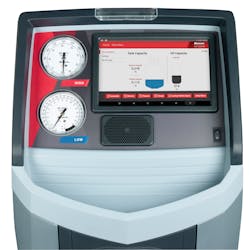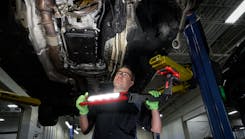Tech Tip: Tools and equipment for R-1234yf
The SAE standard for R-1234yf has different requirements than standards for servicing R-134a vehicles. Some tools can be used for servicing both types of systems, but recovery equipment should never be used on both systems. Any transfer hoses or tanks should also only be used with one refrigerant and never used interchangeably.
Shops will need a separate, dedicated R-1234yf recovery machine to service those systems. POE and PAG oil injectors can also be used on both systems, but should only be used with one type of oil. Refrigerant identifiers and leak detectors can also be used with both refrigerants, as long as the tool was purchased in the last few years and will properly identify, test, or sniff out the new refrigerant.
To service R-1234yf systems, shops will need:
- New, R-1234yf recovery machine
- PAG and POE oil injectors. R-1234yf machines will not automatically inject oil back into the system, requiring technicians to manually measure and inject oil
- Manifold gauges to hook up to the high and low side connectors, which are different from the connectors used on R-134a systems
- A new leak detector that senses R-1234yf. Older leak detectors may not detect yf refrigerant.
Additional safety equipment needed for R-1234yf systems are needed more to ensure the safety and integrity of the vehicle and A/C system than for the technician. This includes a new recovery machine with integrated refrigerant identifier to help avoid cross-contamination of refrigerants and to test the purity of R-1234yf prior to recovery. Dedicated PAG and POE syringe-type oil injectors are also needed to service the belt-driven and electrically-driven compressors that are used in various R-1234yf systems.
Shops will need to invest in a new machine and manual oil injectors, to start with. After that, every technician should take a Section 609 refresher course from MACS to fully understand the differences and service needs for a 134a vs 1234yf system. 1234yf service also takes longer than 134a systems, so shops and techs should be aware of the extended time needed to service vehicles when scheduling service and communicating to customers, roughly 60 to 75 minutes for yf service. The IAM is now starting to see some of those vehicles coming in for service. New service tools have been designed to service and work on the new yf systems. The purpose of new recovery machines is to get the machine and service process started, and be able to do something else while the machine works.
By the end of 2015 there were roughly 8 new vehicles using 1234yf. By the end of this year more than 100 new models will be using 1234yf, with that list continuing to expand the way it did when the switch was made from R12 to R134-a. To service the A/C systems in these vehicles, a new machine is needed per SAE standards. The machine must have an internal refrigerant identifier and will not inject oil into the vehicle’s system – this is a manual process.
By the end of this year more than 100 new models will be using 1234yf.
The importance of a new machine for YF service is to prevent cross-contamination of refrigerants. This is vital to keeping new YF and existing 134a systems working properly. Failure to use the correct machine can damage the vehicle’s AC system and may potentially damage your AC machine. The connectors on the low and high side for 1234yf service are also different than 134a connectors, helping to prevent the incorrect machine being used on the wrong system.
SAE standards and requirements change over the years, creating changes in the automotive aftermarket, including shop equipment. AC machines that are 10 years old or more are less efficient and less accurate than today’s equipment and SAE standards. Using older equipment could result in a shop recovering less refrigerant, losing refrigerant during recovery or mischarging an AC system.
Information provided by Robinair, Bosch Automotive Service Solutions


